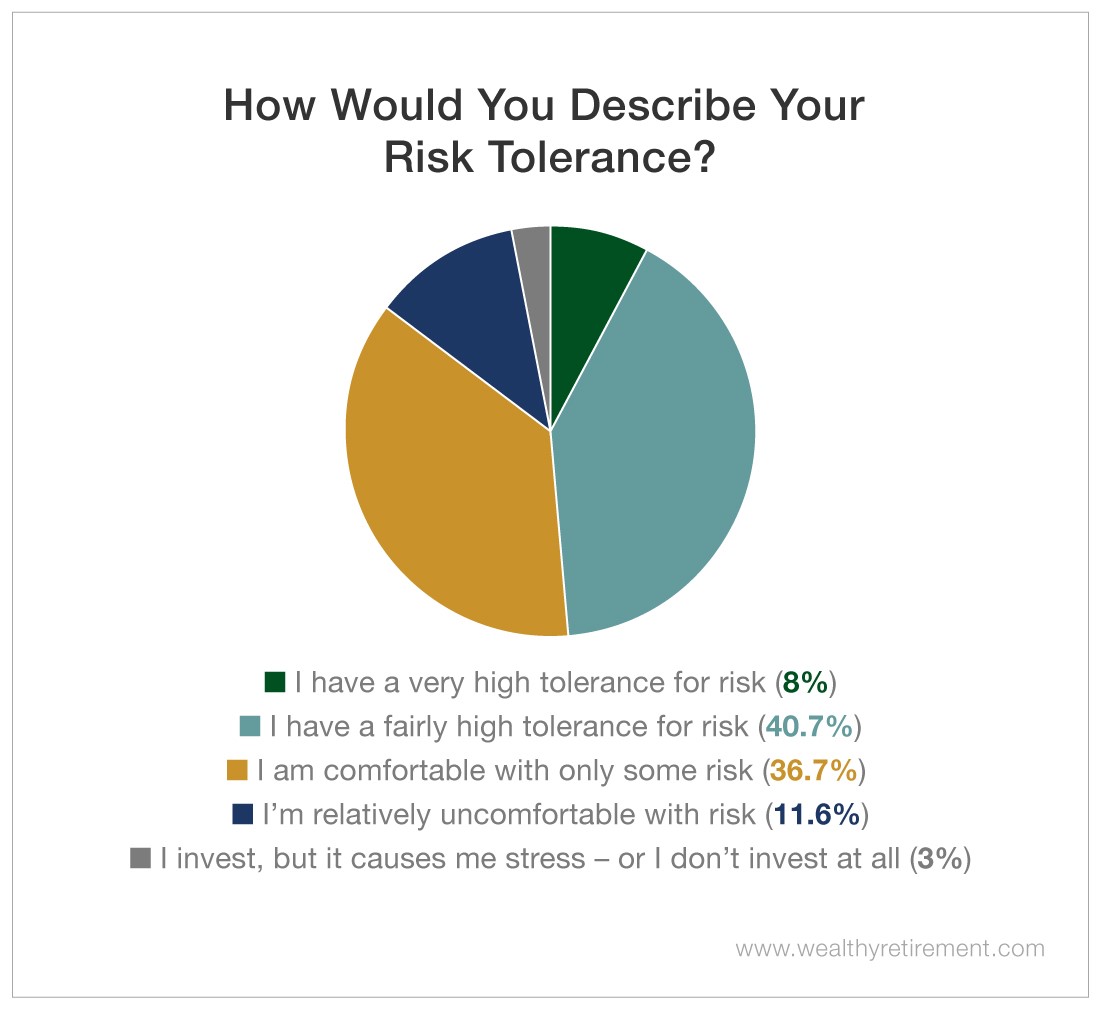The Moment of Truth: How Much Risk Can You Handle?
Recently, the road has been rocky for individual investors…
A struggling global economy augmented by trade wars has led many to wonder whether it’s finally the end of this bull market. If our readers’ survey responses are any indication, the biggest waves are still to come.
This week, we asked our readers what worries them most about the market. We also asked them to rank their risk tolerance.
While many respondents said that their greatest worry is volatility, most indicated that they have a moderate to high tolerance for risk.
On the other end of the spectrum, 36.7% said they were “comfortable with only some risk.”
As many as 11.6% of our readers are “relatively uncomfortable” with volatility. And 3% experience high levels of stress while investing or do not invest at all.
These are important details for investors to know about themselves…
However, as Steve recently pointed out, self-assessments of risk tolerance don’t always tell the whole story.
If you consider yourself a risk-tolerant investor, ask yourself: If the market takes a downturn tomorrow, will I be at peace losing the amount that I have at risk, either in options premiums or in trailing stops?
Consider how you responded in the Great Recession of 2008 to 2009. Maybe your actions matched your self-assessment. Or, if you found yourself losing your cool (and perhaps your nerve), maybe your portfolio wasn’t as prepared as it could have been.
Marc has said before, “What I love about the market is it’s like a puzzle that you never solve… one of the exciting things about this business is you’re always learning something. It’s a never-ending process.”
As you learn a bit more about your risk tolerance, explore whether one of the strategies below might suit your temperament.
Strategy No. 1: Income Investing Using Bonds
“I’m afraid the poor health of the global economy will begin to drag down the markets in the U.S. All of my money tied up in the markets is in my 401(k), and I just retired so I’ll be drawing on it in January 2020 or possibly sooner.” – Wealthy Retirement Reader
If, like many of our readers, you’re kept up at night by volatility, bond investing may provide some peace of mind.
Returns on government bonds are guaranteed, gains on municipal bonds are often tax-free, and corporate bonds yield enough to compete with some stocks. The bond market has something for everyone.
The downside? At 2% yields, the 10-Year Treasury will not net nearly the same level of income that investing in “junk”-rated corporate bonds or common stock can provide.
However, even the lowest-rated junk bonds have had a success rate of 97% over the past five years. If you favor low-risk investing, this approach will likely suit you just fine.
If you want to take your exposure up a notch, consider the next strategy…
Strategy No. 2: Income Investing Using Dividend Payers
“I am keeping all my investments where they have been. I am accepting the bad right now, and hopefully the market will pick up.” – Wealthy Retirement Reader
(Good news, Reader – stocks go up over the long term even if you weather a bear market. Take a look at this piece by Marc and see for yourself.)
If you take a page from Marc’s book and invest in Perpetual Dividend Raisers, you’ll find the closest thing to a guaranteed return that the stock market offers.
With the right resources (look to Marc’s Safety Net column), dividend investing can be a reliable income-generating strategy for anyone.
Or maybe you’re more of a “go big or go home” type…
Strategy No. 3: Income Investing Using Options
“A boring market is no fun.” – Wealthy Retirement Reader
If, like this reader, your retirement is secure and you’re comfortable allocating funds to options, then there’s cause to be excited by the market’s recent turbulence.
When you have experts on your side, calculated plays like put selling, selling covered calls and Long-Term Equity Anticipation Securities (LEAPS) can help you generate higher levels of income.
Trading experts Karim Rahemtulla and Bryan Bottarelli call this “smart speculation.”
They pair their knowledge of company fundamentals with technical analysis to identify the best opportunities in real time.
That kind of market experience pays off. Karim’s favorite options trading strategies are always those that reduce costs while increasing upside. If that interests you, consider dipping a toe in.
Regardless of your risk tolerance…
It Pays to Know Yourself
There are a few modes of risk reduction that are appropriate for all investors to take advantage of:
- Use position sizing – we recommend not holding more than 5% of your portfolio in any one position.
- Set trailing stops – we recommend 25%.
- Diversify across sectors, market caps and geographies.
- Thoroughly research companies.
- Keep funds you need to pay expenses over the next three years in a certificate of deposit (CD) or money market account.
Beyond these simple steps, be aware of how the market affects your stress level.
This is especially valuable information because, as Marc said, the market offers constant opportunities to learn. And in many ways income investing is a matter of choosing your own adventure.
Choose the combination that meets your income goals while setting your mind at ease.
[adzerk-get-ad zone="245143" size="4"]








